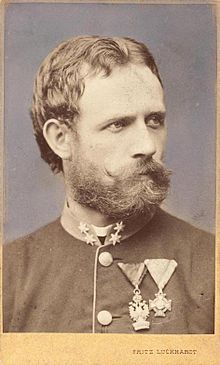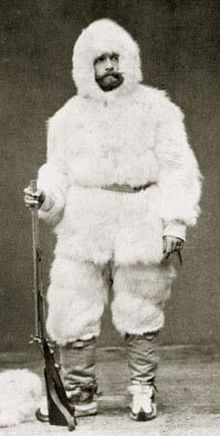Julius von Payer
Julius von Payer | |
|---|---|
 Julius Payer as First Lieutenant (around 1865) | |
| Born | 2 September 1841 |
| Died | 29 August 1915 (aged 73) |
| Resting place | Vienna Central Cemetery |
| Nationality | Austrian |
| Known for | Austro-Hungarian North Pole expedition |
Julius Johannes Ludovicus Ritter von Payer (2 September 1841 – 29 August 1915), ennobled Ritter von Payer in 1876, was an officer of the Austro-Hungarian Army, mountaineer, arctic explorer, cartographer, painter, and professor at the Theresian Military Academy. He is chiefly known for the Austro-Hungarian North Pole expedition in 1872–74 and the discovery of Franz Josef Land.
Early life and military career
Born in
From 1859, Payer served as a sub-lieutenant with the Austrian 36th infantry regiment in Verona, Venetia. He participated in the disastrous Battle of Solferino on 24 June 1859 and was honoured for his service. After promotion to the rank of lieutenant first class, he was posted to the garrison of Chioggia, Venetia in 1864. On 24 June 1866 he served the Battle of Custoza, seizing two guns, for which he was decorated and elevated to the rank of senior lieutenant.
Since 1863 Payer was assigned as a history and geography teacher to the cadet school in Eisenstadt, Kingdom of Hungary (1526–1867) (present-day Austria) and to the Theresian Military Academy. In 1868 the Austro-Hungarian Minister of War Franz Kuhn von Kuhnenfeld appointed him a general staff officer at the k.k. Military Geographic Institute in Vienna, where he worked with August von Fligely.
Alpine exploration
In 1862 Payer had started exploratory tours of the
His tours resulted in creating a detailed
Polar expedition

In 1868 he was invited by the German geographer
From 1872 to 1874, Payer led the
However, on 24 October 1876 he was elevated to the Austrian nobility which entitled him and his descendants to the style of Ritter von in the case of male and von in the case of female offspring.
Later life
This section needs expansion. You can help by adding to it. (June 2022) |
In 1877 Ritter von Payer married the ex-wife of a banker from
From 1877 to 1879 he studied painting with Heinrich Hasselhorst at the Städelschule in Frankfurt am Main. From 1880 to 1882 he continued his study of art at the Academy of Fine Arts, Munich.
From 1884 to 1890 he worked as a painter in Paris.
In 1890 he divorced his wife, returned to Vienna and founded a painting school for ladies.
In 1895 he planned a trip for painting to
In 1912 he planned (at the age of seventy) an expedition in a submarine to the North Pole.
He died in Veldes, in historic Upper Carniola, today part of Slovenia, in 1915.
Named after Julius von Payer

Besides the Payerhütte mentioned above and several streets in Vienna, an island of Franz Josef Land (Payer Island), the Payer Mountains in Antarctica and Payer Land in eastern Greenland have been named after Julius von Payer.
The southern satellite camp for the PolAres MARS2013 analog mission by the
, was named Station Payer during February 2013, after the main base camp had been called Camp Weyprecht during the landing ceremony in the morning of February 11, 2013.See also
- The Austro-Hungarian polar expedition led by Julius von Payer was selected as main motif for the Austrian Admiral Tegetthoff Ship and The Polar Expedition commemorative coin minted on 8 June 2005. The reverse side of the coin shows two explorers in Arctic gear (one of them resembling von Payer) with the frozen ship "Admiral Tegetthoff" behind them.
- Payer Island
Bibliography
- Julius von Payer, Die Österreich-Ungarische Nordpol Expedition in den Jahren 1869–1874 (Wien 1876) (The Austro-Hungarian North Pole Expedition of 1869 to 1874", Vienna, 1876)
- Andreas Pöschek Archived 2006-06-22 at the Wayback Machine: Geheimnis Nordpol. Die Österreichisch-Ungarische Nordpolexpedition 1872–1874. - Wien: 1999 (download as PDF Archived 2006-07-21 at the Wayback Machine)
References
- ^ "List of Past Gold Medal Winners" (PDF). Royal Geographical Society. Archived from the original (PDF) on 27 September 2011. Retrieved 24 August 2015.
External links
- Works by or about Julius von Payer at Internet Archive
- Website of the Payer Hütte located in the Ortler Alps
